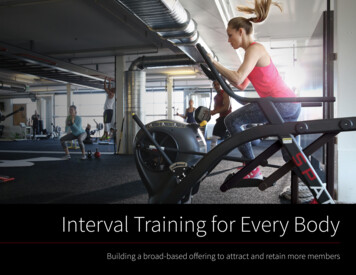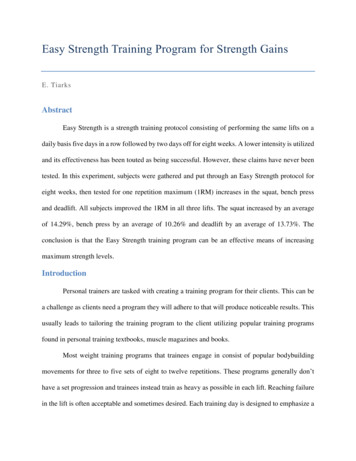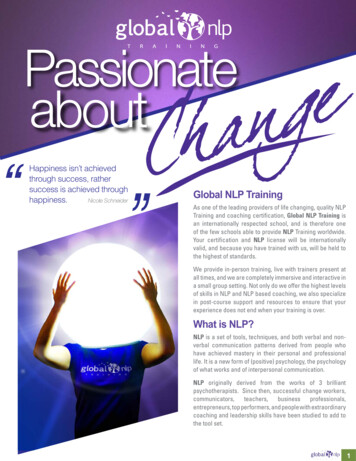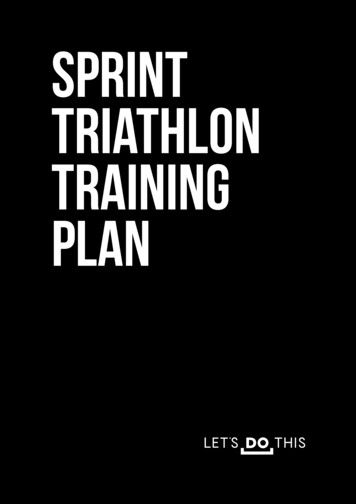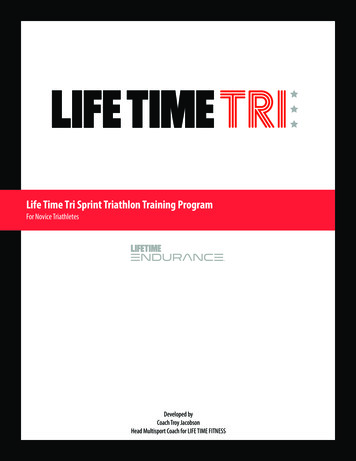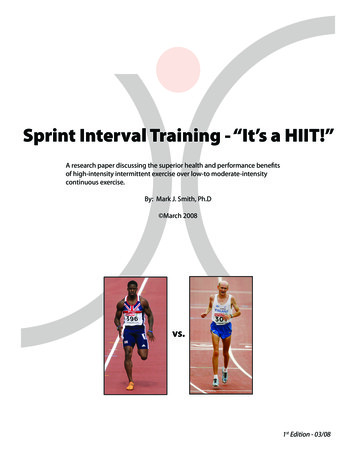
Transcription
Sprint Interval Training - “It’s a HIIT!”A research paper discussing the superior health and performance benefitsof high-intensity intermittent exercise over low-to moderate-intensitycontinuous exercise.By: Mark J. Smith, Ph.D March 2008vs.1st Edition - 03/08
Table of ContentsIntroduction. 1Superior Benefits of High‐Intensity Intermittent Exercise . . . . . . . . . . . . . . . . . . . . . . . . . . . . . . . . . . . . . . . . . . . . . . 3Historical Perspective of Exercise Recommendations. 3High‐intensity Intermittent Training from a Common Sense Viewpoint . . . . . . . . . . . . . . . . . . . . . . . . . . . . . . . . . . 6Cardiovascular Health and High‐intensity Intermittent Training Research . . . . . . . . . . . . . . . . . . . . . . . . . . . . . . . . 7HIIT for the Deconditioned IndividualHIIT for All Age Groups. . . . . . . . . . . . . . . . . . . . . . . . . . . . . . . . . . . . . . . . . . . . . . . . . . . . . . . . . . . . . 11. . . . . . . . . . . . . . . . . . . . . . . . . . . . . . . . . . . . . . . . . . . . . . . . . . . . . . . . . . . . . . . . . . . . . . . . . 16Weight Loss, Fat Metabolism and High‐intensity Intermittent Training . . . . . . . . . . . . . . . . . . . . . . . . . . . . . . . . . 18High‐intensity Intermittent Training and Improved Lactate Tolerance . . . . . . . . . . . . . . . . . . . . . . . . . . . . . . . . . . 22Other Physiological Benefits of High‐intensity Intermittent Training. . . . . . . . . . . . . . . . . . . . . . . . . . . . . . . . . . . 23Application of Sprint Interval Training and High‐intensity Intermittent Training. . . . . . . . . . . . . . . . . . . . . . . . . 24Case Studies of Sprint Interval Training and High‐intensity Intermittent Training . . . . . . . . . . . . . . . . . . . . . . . . . 31Closing Comments. . . . . . . . . . . . . . . . . . . . . . . . . . . . . . . . . . . . . . . . . . . . . . . . . . . . . . . . . . . . . . . . . . . . . . . . . . . . . 36References . . . . . . . . . . . . . . . . . . . . . . . . . . . . . . . . . . . . . . . . . . . . . . . . . . . . . . . . . . . . . . . . . . . . . . . . . . . . . . . . . . . . 38Author’s Biography. . . . . . . . . . . . . . . . . . . . . . . . . . . . . . . . . . . . . . . . . . . . . . . . . . . . . . . . . . . . . . . . . . . . . . . . . . . . 46i
IntroductionBy HIIT, I do not mean that it is popular (although, finally and thankfully, it is certainly becoming so), butrather, that sprint interval training (SIT) is also referred to as high‐intensity interval training or HIIT. It is of majorimportance that health care professionals make sure that the general public, as well as many contemporaries, getthoroughly educated about the superior health and fitness benefits of SIT, or “burst” training, as compared to low‐to moderate‐intensity continuous training (LMICT). This is because, despite research to the contrary, most peoplestill believe that to develop a healthy heart and to lose weight, the best mode of exercise is long and continuous“cardio” exercise, which, inherently, requires a significant investment of time. And, of course, lack of time is thenumber one excuse given for not complying with an exercise program. Before getting into the health and fitnessbenefits of SIT or HIIT, I want to make some clarifications about the definitions and also make a few commentsabout training for individuals that want to take part or compete in endurance events.Interval training refers to intermittent exercise involving periods of exercise followed by periods ofrecovery, which enables anyone to increase the intensity of the exercise workload. A pretty simple concept. Theproblem, however, with the term “high‐intensity” is that it is descriptive and, obviously, relative to an individual’slevel of fitness and dependant upon one’s tolerance to exertion. Running at five miles per hour may be an all‐outeffort for some, whereas, it may be a walk in the park for others. While it is easy to assign relative exerciseintensities for both training and research purposes by first measuring maximal capacities, one also needs tounderstand that the term “high‐intensity” is used in the scientific literature to describe intensities ranging from aslow as 85% of maximal oxygen uptake (VO2 max or aerobic capacity) to as high as 250%. These intensities alsoneed clarifying for people who incorrectly assume that 100% VO2 max indicates an all‐out effort, which is not thecase; if it did, studies could not prescribe intensities above 100% VO2 max. These exercise intensities are related tothe maximal workload achieved when measuring an individual’s VO2 max in a progressively‐graded exercise stresstest that can last for 10 or more minutes. This is not the same as asking someone to sprint as fast as they can for,say, 20 seconds; the workload or speed, in this case, would be considerably higher than the workloadcorresponding to 100% VO2 max. For example, if the workload on a treadmill eliciting VO2 max was 8 mph at a 5%1
grade, then a workload corresponding to 150% VO2 max would be 12 mph at a 5% grade (i.e., one and a half timesthe VO2 max workload). Further, for many individuals, even this workload would be well short of an all‐out effort.When one is exercising above 100% VO2 max, it is termed “supra‐maximal” and essentially defines SIT. Because ofthe wide range of intensities reported in the research for HIIT, the duration of the exercise interval can also rangefrom as low as six seconds to as high as four minutes and sometimes even longer. Further, the recovery intervalused in HIIT can vary considerably. As a consequence, these issues need to be elucidated when using the term“HIIT” because, when used alone, it can be limiting in terms of understanding the exercise prescription. Incontrast, SIT defines a narrower range of intensities that essentially fall within a time constraint of one minute orless. This is simply because, for any human, the intensity of a maximal effort drops off precipitously when theduration goes beyond sixty seconds.Now, the necessary LMICT that endurance athletes employ in their conditioning programs is irrelevant inthe scope of this article since I am not arguing that endurance athletes do not need to do “volume” training. I will,however, argue that endurance athletes, while extremely impressive in their physical accomplishments, are not thehealthier athletes when compared to sprinters. Further, while the endurance athlete has a need to maintain a highsubmaximal intensity for long periods to be successful, the vast majority of athletes, and certainly humans ingeneral, have no need for this type of activity as will be discussed later. It is also noteworthy that interval trainingis not some new concept to the endurance athlete. They have long employed SIT and HIIT and, for many eliteendurance athletes today, HIIT can comprise as much as 50 to 75% of their total training volume. I do not think theaverage person starting an exercise program realizes this; rather, I believe they think athletes such as LanceArmstrong simply ride their bikes nonstop to achieve their incredible levels of cardiovascular endurance. Whilethere is considerable debate as to the magnitude of the intensity and how much interval training an enduranceathlete should include in his or her conditioning program, all successful endurance athletes employ a significantamount of HIIT in their training protocols. However, the HIIT many typically employ is, relatively, at the low end ofthe intensity spectrum with work intervals often lasting four or more minutes in length. As will be demonstrated inthis article, I believe even the endurance athlete would benefit considerably by reducing their volume training and2
supplementing their “low‐ to moderate‐intensity” HIIT with a significant amount of supra‐maximal HIIT. Thisthought is supported by a study that investigated the relationship between tests of anaerobic (non‐oxidativemetabolism) power and 10K running performance and which demonstrated that all tests of anaerobic power weresignificantly correlated with 10K run time and just one plyometric leap test accounted for nearly 75% of thevariance in 10K run time1. When combined with the 300‐m sprint time, the variance in 10K run time increased tonearly 80%. However, the wisdom of my recommendation to the endurance athlete is relatively unimportantwhen one considers that the most pressing issue for society is getting the general public to engage in a successfulexercise program that improves their overall health, not to help them cross the finish line in April near FenwayPark.Superior Benefits of High‐Intensity Intermittent ExerciseSo, back to the education about the superior health and fitness benefits of HIIT. I have been at theforefront of this issue since the mid‐1990s and, I can say with experience, it has been an uphill battle to undo somevery indoctrinated thinking. The reason for this indoctrination is likely due to a number of causes – chief amongthem is the fact that early sport science research focused, from a relative perspective, almost exclusively, onLMICT. This then led to a saturation of the scientific journals with this type of research. So why this focus?Historical Perspective of Exercise RecommendationsOne can never be certain as to why history takes its course; however, in my opinion, a pioneering articleby Hollowszy in 1967 likely led the way for a concentrated examination of the effect continuous exercise had onoxidative metabolism2. The study demonstrated a twofold increase in mitochondrial enzymes (i.e., an increase inaerobic capacity) of rat skeletal muscle in response to strenuous treadmill running. While the majority of the earlystudies that followed continued to focus on the effect continuous exercise had on oxidative metabolism, someresearchers did examine HIIT. Interestingly, Hollowszy’s running protocol, by the end of the 12‐week trainingperiod, included 12, 30‐second sprints. Unfortunately, the physiological effect of the sprints was not differentiatedfrom the majority of the continuous running by the rats. Edwards, et al. conducted the first detailed analysis of3
cardiorespiratory and metabolic adaptations to continuous versus intermittent exercise as early as 19733. Despitethe equal power output of the exercise protocols, intermittent exercise, as compared to continuous exercise, wasshown to elicit higher heart rate, ventilation, oxygen utilization and lactate production, which was attributed to alower work efficiency with HIIT. While some may hear a lower work efficiency as a bad thing, when it comes toexercise and improving health and fitness, I am constantly telling people that we want to be like an inefficient high‐octane fuel engine, much like a high performance Ferrari with poor gas milage, not a fuel‐efficient diesel truck! In1977, another study compared continuous versus interval training of a matched daily workload4. It was discoveredthat both training protocols had a similar improvement (i.e., approximately 26 minutes) in cycling time toexhaustion at 90% VO2 max, despite the significantly lower time commitment of the interval training. So, althoughstudies in the earlier days of exercise science did demonstrate the effectiveness of HIIT, another pioneering studyby Gollnick et al. chose to examine the effect of continuous endurance training upon muscle physiology and furtherfocused the spotlight on this type of training5. At around the same time, the running craze of the 70's, which madejogging a popular activity, coincided with the developing sport science discipline. Further, the metabolicrespiratory equipment at that time did not have the ability to measure oxygen concentrations from small volumesof expired air (what is now called, breath by breath analysis) and it was less complicated to measure expired airfrom one long bout of continuous exercise rather than multiple bouts of high‐intensity exercise. This likely biasedthe research toward activities that were of a long, continuous duration and, by natural default, activities that wereof a low‐ to moderate‐intensity. Try sprinting for 20 minutes or, for that matter, just more than only one minute.As a consequence, the published research from the late 70's to the mid 90's, which clearly resulted in adisproportionate focus on LMICT, had a profound influence on the medical community, the fitness industry, andeven the sports conditioning world. It is somewhat ironic that one of the pioneers of exercise physiology, Per‐OlofÅstrand, who presented the method of how to measure maximal aerobic capacity at the 1967 Proceedings of theInternational Symposium on Physical Activity and Cardiovascular Health, warned that “too often bold conclusionsabout the individual’s physical fitness and maximal performance are drawn from knowledge of [their] maximaloxygen uptake.”64
Ultimately, the training affect on the cardiovascular system and oxidative metabolism from LMICT led to itbeing labeled “cardio” or “aerobic” exercise and to the thought process that this type of training, and only this typeof training, would positively condition the cardiovascular system. This same process and resultant thinking playedout with the research examining fat metabolism and “burning” fat stores. It eventually lead to the early AmericanCollege of Sports Medicine guidelines that spread the doctrine of engaging in rhythmical “aerobic” activities threeto five times per week, for 20 to 60 minutes at an intensity of 60‐90% of maximal heart rate reserve or 50‐85% ofmaximal aerobic capacity7. As already noted, the recommended duration of exercise was heavily influenced by themetabolic equipment of that time, which, in turn, dictated the exercise intensity; anyone exercising at 60‐90% oftheir maximal heart rate reserve will, by physiological default, last about 20 to 60 minu
rather, that sprint interval training (SIT) is also referred to as high‐intensity interval training or HIIT. It is of major importance that health care professionals make sure that the general public, as well as many contemporaries, get thoroughly educated about the superior health and fitness benefits of SIT, or “burst” training, as compared to low‐ to moderate‐intensity continuous .
